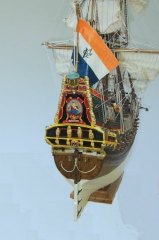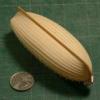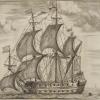
T. Pevny
Members-
Posts
7 -
Joined
-
Last visited
Recent Profile Visitors
-
 Mark P reacted to a post in a topic:
Mathew Baker's early concept of ship hull design, ca. 1570
Mark P reacted to a post in a topic:
Mathew Baker's early concept of ship hull design, ca. 1570
-
 T. Pevny reacted to a post in a topic:
William Sutherland's concept of ship hull design, 1711
T. Pevny reacted to a post in a topic:
William Sutherland's concept of ship hull design, 1711
-
Mathew Baker's early concept of ship hull design, ca. 1570
T. Pevny replied to Waldemar's topic in Nautical/Naval History
@Waldemar Waldemar - I have read through the London thread, and I have a few thoughts and drawings that I hope to share; I think some very important points were raised between all the bickering. I need to read the Sutherland thread and the Moneypenny & Antscherl article has long been on my re-read and study list (it has been a hard few years, so I am a little behind). Right now I'm not informed enough with the material to even put a like on a post. -
 GrandpaPhil reacted to a post in a topic:
Mathew Baker's early concept of ship hull design, ca. 1570
GrandpaPhil reacted to a post in a topic:
Mathew Baker's early concept of ship hull design, ca. 1570
-
 GrandpaPhil reacted to a post in a topic:
Mathew Baker's early concept of ship hull design, ca. 1570
GrandpaPhil reacted to a post in a topic:
Mathew Baker's early concept of ship hull design, ca. 1570
-
 Mark P reacted to a post in a topic:
Mathew Baker's early concept of ship hull design, ca. 1570
Mark P reacted to a post in a topic:
Mathew Baker's early concept of ship hull design, ca. 1570
-
 Mark P reacted to a post in a topic:
Mathew Baker's early concept of ship hull design, ca. 1570
Mark P reacted to a post in a topic:
Mathew Baker's early concept of ship hull design, ca. 1570
-
 T. Pevny reacted to a post in a topic:
Mathew Baker's early concept of ship hull design, ca. 1570
T. Pevny reacted to a post in a topic:
Mathew Baker's early concept of ship hull design, ca. 1570
-
 Waldemar reacted to a post in a topic:
Mathew Baker's early concept of ship hull design, ca. 1570
Waldemar reacted to a post in a topic:
Mathew Baker's early concept of ship hull design, ca. 1570
-
 T. Pevny reacted to a post in a topic:
2nd rate London 1656 – the art of the shipwright
T. Pevny reacted to a post in a topic:
2nd rate London 1656 – the art of the shipwright
-
 T. Pevny reacted to a post in a topic:
2nd rate London 1656 – the art of the shipwright
T. Pevny reacted to a post in a topic:
2nd rate London 1656 – the art of the shipwright
-
 T. Pevny reacted to a post in a topic:
2nd rate London 1656 – the art of the shipwright
T. Pevny reacted to a post in a topic:
2nd rate London 1656 – the art of the shipwright
-
 T. Pevny reacted to a post in a topic:
2nd rate London 1656 – the art of the shipwright
T. Pevny reacted to a post in a topic:
2nd rate London 1656 – the art of the shipwright
-
 T. Pevny reacted to a post in a topic:
2nd rate London 1656 – the art of the shipwright
T. Pevny reacted to a post in a topic:
2nd rate London 1656 – the art of the shipwright
-
 mtaylor reacted to a post in a topic:
Mathew Baker's early concept of ship hull design, ca. 1570
mtaylor reacted to a post in a topic:
Mathew Baker's early concept of ship hull design, ca. 1570
-
 mtaylor reacted to a post in a topic:
Mathew Baker's early concept of ship hull design, ca. 1570
mtaylor reacted to a post in a topic:
Mathew Baker's early concept of ship hull design, ca. 1570
-
Mathew Baker's early concept of ship hull design, ca. 1570
T. Pevny replied to Waldemar's topic in Nautical/Naval History
True. I should have written "enough of a motivating factor":))) Just kidding. We do know that level of care (skill; particularly mathematical & graphic skill) varied with the shipwright. So in this period there is no discounting exploration by individuals (and their motivations). So I am not discounting it. I really need to go to these original London posts. Although, I should say, that sometimes it takes me years to settle on an conclusion:) Oh - I see - the London thread was closed; it is a shame it came to that. -
 T. Pevny reacted to a post in a topic:
Mathew Baker's early concept of ship hull design, ca. 1570
T. Pevny reacted to a post in a topic:
Mathew Baker's early concept of ship hull design, ca. 1570
-
 T. Pevny reacted to a post in a topic:
Mathew Baker's early concept of ship hull design, ca. 1570
T. Pevny reacted to a post in a topic:
Mathew Baker's early concept of ship hull design, ca. 1570
-
 B-Ram reacted to a post in a topic:
Mathew Baker's early concept of ship hull design, ca. 1570
B-Ram reacted to a post in a topic:
Mathew Baker's early concept of ship hull design, ca. 1570
-
 Waldemar reacted to a post in a topic:
Mathew Baker's early concept of ship hull design, ca. 1570
Waldemar reacted to a post in a topic:
Mathew Baker's early concept of ship hull design, ca. 1570
-
Mathew Baker's early concept of ship hull design, ca. 1570
T. Pevny replied to Waldemar's topic in Nautical/Naval History
One of the benefits when someone presents such ideas (& graphic analysis that one can look at in detail) is that it inspires you to take a much closer look at the drawing and comparative materials- radii and all. I will go to that thread and give it a careful read. The drawing is certainly worth the attention. -
 T. Pevny reacted to a post in a topic:
Mathew Baker's early concept of ship hull design, ca. 1570
T. Pevny reacted to a post in a topic:
Mathew Baker's early concept of ship hull design, ca. 1570
-
Mathew Baker's early concept of ship hull design, ca. 1570
T. Pevny replied to Waldemar's topic in Nautical/Naval History
I saw that exchange Waldemar -" jarring style" is one way to put it. Richard Endsor does very nice work & is very diplomatic:) Varying radii to gain design flexibility is an interesting topic. Eventually, it became apparent that all the "geometric fairing" systems might just need to be abandoned for "optical fairing" after the introduction of as much variability in radii as possible and a whole web of "controlling" and additional "fairing" lines. I tend to think that varying floor radii at that early time might have lacked a motivating factor (so maybe other explanations/possibilities in terms of the draft should be thoroughly explored, but... ). With introducing varying radii one always has to consider how the variability was controlled. -
Mathew Baker's early concept of ship hull design, ca. 1570
T. Pevny replied to Waldemar's topic in Nautical/Naval History
As a person very devoted to quality in this field of research I am moved by your comments Waldemar and by the warm reception I have received from the members of this Forum as a whole. I am excited by the prospect of future exchanges of ideas! P.S. @Waldemar I am of the same thinking in terms of our work being an interesting case of confirmation of ideas by independent work. I have looked enough at drawings and such studies to know you never saw my work on English design before today. We can both still be wrong together:) but I think it adds weight to the underlying ideas. -
Mathew Baker's early concept of ship hull design, ca. 1570
T. Pevny replied to Waldemar's topic in Nautical/Naval History
@trippwj Wayne - I am so happy you are familiar with my website. Some day I hope to get back to it. I think the format that I created for the posts (with perpetual updates that could be referenced) has a lot of potential, but since I was building the web site myself from scratch - it was very time consuming. For others that may not have seen my website is tangencypress.com (hopefully one day active again). I found the Nowacki (and company) publications very exciting at the time they came out (& the associated workshop...). I was hoping that level of intensity of work and exchange of ideas on ship design would continue - maybe it still will one day. I actually think that model building - like you all do - is critical to the research as well. Richard Steffy - as you no doubt all know - was a committed research model builder. I worked building a partial full-scale "reconstruction" of the 7th-century Yassiada vessel in a museum in Turkey, and Mr. Steffy's original model was in the room as a reference (as well as often the original reconstructor of the archaeological remains - Fred van Doorninck). I love working with original written sources, but ultimately one has to establish/confirm their relationship to the practical realities of shipbuilding (at whatever scale possible & affordable:) -
Mathew Baker's early concept of ship hull design, ca. 1570
T. Pevny replied to Waldemar's topic in Nautical/Naval History
@Waldemar @trippwj @druxey @Mark P @B-Ram @Louie da fly @James H @Richard Endsor Dear Waldemar and other followers of this topic - I have never been active on any forum, so I hope I manage here. I agree with Waldemar that despite numerous important articles etc. on Baker's Fragments... graphic analysis of the type he has been posting is rare. Rare - but not non-existent:) The following is a link ( T. Pevny 2019 Early English Ship Design ) to my MA 2019 thesis in which I present similar work on the same Baker drawing. It has about 60 pages of text and about 200 figures. Your work - Waldemar - and mine led us in a similar direction. I hope everyone that reads it will find it interesting. If there is an interest - I would love to continue a discussion with all of you (posting images etc. as is common on this forum). I thank you Waldemar - because your posts made me finally make my study more widely accessible via Academia.edu. I know that Waldemar also posted his analysis of the Mary Rose design in a separate thread. He disagrees with the conclusions on the design in the published official volume on the hull. I agree with him - I also think the official analysis is flawed. This is also discussed in my study, with figures. Waldemar - you also recommended that the design conclusions (as published) for the Basque whaler need re-examination. I agree - and I address this in my study along with a long look at the design theories of Brad Loewen. I hope others that commented recommending various articles that needed to be referenced will be satisfied by my literature review. I want to be clear - I am thrilled that Waldemar's graphic analysis led him to examine the Baker drawing and the Mary Rose. I have been a proponent of the need for similar graphic research. But:) Waldemar maybe your "bedside manner" needs a little work:) One thing you can count on in a forum such as this is the love and enthusiasm of the members for the subject. But I do understand your excitement! I am speculating with the following - but here it goes. Back in the late 1990s - early 2000s I was working out my ideas on Mediterranean moulding and other design methods using models and countless drawings. I also had the privilege of dismantling and reassembling the remains of a small 17th century ship three times while working in a conservation lab. While doing this work - research and reconstruction drawings on French design and Mediterranean moulding - my ideas made me start seeing fundamental flaws in a series of design studies (whose conclusions were leaking out in Symposium presentations, articles..) on the Basque whaler, Mary Rose, an "Atlantic design method"... It was my thought that my graphic studies of Mediterranean moulding etc. were making me "see" things differently. I wonder - and would be thrilled if this was even a little so - that my published work influenced Waldemar in the same way. This past September Waldemar uploaded (with very kind words) my study "Capturing the Curve: Underlying Concepts in the Design of the Hull" that presents an early archaeological example of the French diagonal method of ship design as well as Mediterranean moulding. I am thrilled that 77 members of this forum downloaded it (it is public). Here is my link for it on Academia.edu T. Pevny 2017 La Belle design study The warmest greetings to all of you! Taras Pevny
About us
Modelshipworld - Advancing Ship Modeling through Research
SSL Secured
Your security is important for us so this Website is SSL-Secured
NRG Mailing Address
Nautical Research Guild
237 South Lincoln Street
Westmont IL, 60559-1917
Model Ship World ® and the MSW logo are Registered Trademarks, and belong to the Nautical Research Guild (United States Patent and Trademark Office: No. 6,929,264 & No. 6,929,274, registered Dec. 20, 2022)
Helpful Links
About the NRG
If you enjoy building ship models that are historically accurate as well as beautiful, then The Nautical Research Guild (NRG) is just right for you.
The Guild is a non-profit educational organization whose mission is to “Advance Ship Modeling Through Research”. We provide support to our members in their efforts to raise the quality of their model ships.
The Nautical Research Guild has published our world-renowned quarterly magazine, The Nautical Research Journal, since 1955. The pages of the Journal are full of articles by accomplished ship modelers who show you how they create those exquisite details on their models, and by maritime historians who show you the correct details to build. The Journal is available in both print and digital editions. Go to the NRG web site (www.thenrg.org) to download a complimentary digital copy of the Journal. The NRG also publishes plan sets, books and compilations of back issues of the Journal and the former Ships in Scale and Model Ship Builder magazines.





